They Sank My Boat
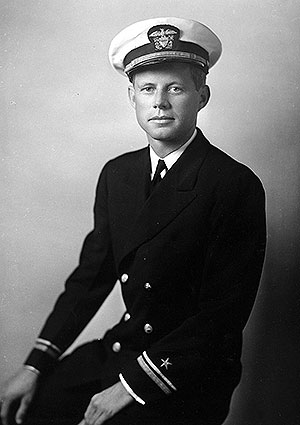
John F. Kennedy Presidential Library and Museum Photograph by Frank Turgeon Jr.
President John F. Kennedy is arguably one of America’s greatest U.S. Presidents. Elected in 1960, he brought an energy and grace to the Oval Office. His humanity in pursuing civil rights in the United States elevated him to a visionary level of both Presidents Lincoln and Washington. Yet, he is also the first and possibly only US President to be faced with one of the world’s most critical moments when the United States and the Soviet Union were on the verge of engaging in global nuclear thermal warfare in 1962. This would be a post-World War II event that could plunge the global climate into a nuclear winter and kill millions. The Soviets were establishing missile bases in Cuba 90 miles from the tip of Florida. Was the Russian Premier Khrushchev testing the young Kennedy? Kennedy made a pivotal decision by ordering the U.S. Navy to create a blockade around the Caribbean Island of Cuba. The world held its breath and waited to see who would back down first. Kennedy prevailed.
John F. Kennedy’s strength of character and leadership was influenced by many aspects of his life. One of the most influential periods could easily have been his tenure as a naval combat officer in the South Pacific fighting the Japanese following the attack on Pearl Harbor. His ability to make quick decisions under stress with the welfare of those around him would be put to the test like no other on a fateful August night in 1943. It was one of those moments he learned you do what you’ve got to do. He was lauded a hero for which he said "it was involuntary, they sank my boat".
"Any man who may be asked in this century what he did to make his life worthwhile, I think can respond with a good deal of pride and satisfaction, 'I served in the United States Navy,'" wrote President John F. Kennedy in August 1963.
From Harvard Man to Naval Officer

Frank Turgeon and Turgeon Studios
Young John F. Kennedy’s future was one of privilege and opportunity with his graduation from Harvard University in 1940. He had previously attended the London School of Economics and was entering graduate school at Stanford University in California when he paused, with all of America to intently listen to President Roosevelt’s galvanizing declaration following the surprise attack on Pearl Harbor ending with “a date which will live in infamy”. Young Kennedy’s nation was now at war.
Older brother Joe joined the Navy and was training to be a pilot. John whom friends and family called Jack, wanted in on the action too. The problem was Jack had a bad back and it was doubtful the Navy would take him. The family patriarch Joseph Kennedy relied on a few well-placed connections to help his second eldest son. The elder Kennedy was the U.S. ambassador to Great Britain and good friends with Captain Alan Kirk who was the Director of Naval Intelligence. This was the break young Jack needed to get his foot in the door and he was soon assigned as an ensign in the Naval Reserves serving in intelligence. His initial duties with the Navy were modest at best shuffling between office bound assignments stateside. Ensign Kennedy’s next big break came when he was able to attend Officers Training School in the late summer of 1942. This set him up for his big chance he had so longed for where he could contribute and command as an officer. It was a calling based on his skills and passions from a life of growing up on Cape Cod among the sleek and fast luxurious wooden hulled motorboats effortlessly skimming across the waves on weekends. A Patrol Torpedo (PT) Boat skipper had arrived ready for duty.
Ensign John F. “Jack” Kennedy was finally was at the helm of his own boat with the salt air spray in his face and the ocean chop bouncing him and his crew across the waves aboard the roaring PT 101. The 101 was a 78-foot Higgins boat which was one of two variants the Navy was fielding along with the slightly larger Elco PTs. His time aboard the 101 was only for training with the Navy’s Motor Torpedo Squadron Four located in Melville, Rhode Island and later for testing in the tropics in Panama, but it gave the young officer the thrill of commanding a roaring wooden hulled boat across the sea but this time with a compliment of torpedoes and heavy machine guns. The PT boats were the US Navy’s concept for quick attacks and for close in shore support.
Combat Command and the PT-109

John F. Kennedy Presidential Library and Museum
Promoted to Lieutenant Junior Grade (JG) Kennedy entered combat with an assignment to Motor Torpedo Boat Squadron Two based in the Solomon Islands in the South Pacific in 1943. It was there he boarded “his” PT boat. Finally he had his first combat command. It was the PT-109. She was an Elco type. The bigger of the two variants by about 10 feet complete with a formable array of torpedoes, heavy machine guns and depth charges. No time to waste for the young Kennedy as he skippered the 109 with several other PT Boats away from the Solomons towards the Russel Islands as the US Navy prepared for the invasion of New Georgia. Soon Kennedy and his crew of eleven sailors were conducting nightly attacks on Japanese barge traffic frantically attempting to resupply their isolated garrisons in New Georgia. The US Navy used the lightning speed of the PT boat to attack with quick surprise launching torpedoes and strafing the enemy craft with 50 caliber heavy machine gun rounds. The boat’s speed allowed for a quick exit before counter attacks could be a serious threat.
The crew of the 109 also found themselves on patrol in and around the remote islands serving as lookouts for the larger more formidable Japanese destroyers and cruisers that may attempt to attack US warships or US Marines on beach heads in the New Georgia-Rendova area. The only real weapon the PT boat had when facing off with the venerable much larger and heavier destroyers was speed, the quick release of torpedoes and a rapid exit before the large guns of the destroyer could attempt to fix their targets. The PT boats and their crews would easily succumb to a single blast from a destroyer’s heavy guns. It was speed or nothing.
Collision with a Japanese Destroyer
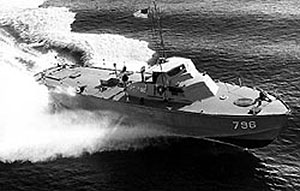
United States Navy
The 109 joined fifteen PT boats on patrol on a dark night in early August 1943 to intercept Japanese warships in the straits. Fellow PT skipper Ensign George Ross with his boat out of commission joined Kennedy aboard the 109. The group engaged several Japanese destroyers firing their complement of torpedoes and withdrawing, but due to the unreliability of American torpedoes in the early stages of the war the attack did not affect much damage. Kennedy and crew on the 109 stayed in reserve with a few other boats to protect against counterattack by lingering as the attacking boats withdrew. Kennedy kept his speed to a crawl hoping to keep the wake and noise to a minimum in order to avoid detection. At 2 a.m. Kennedy noted a vague silhouette of vessel approaching in the darkness. His first thought was another friendly PT boat slowly approaching. Soon he realized it was the massive Japanese destroyer Amagiri traveling at 40 knots. Kennedy attempt to steer his boat into a firing position but before he could react, the massive destroyer slammed broadside into the much smaller wooden boat cutting the PT 109 in two in ten seconds. Ironically the Japanese destroyer didn’t even realize that they had struck an enemy vessel and kept motoring forward soon out of earshot. The tremendous impact had thrown Kennedy into the cockpit where he landed on his bad back. As the chaos and short lived ensuring flames doused by the destroyer’s wake subsided, Kennedy and 4 of his sailors clung to some wreckage of the 109. He called out into the darkness and could hear 5 other members of his crew somewhere in the darkness of the now quiet sea. Sadly two of his sailors were killed upon impact with the destroyer. Kennedy, a champion swimmer from his time at Harvard made his way to his forlorn crew pulling them all to the relative safety of the floating wreck of the 109.
Stranded at Sea
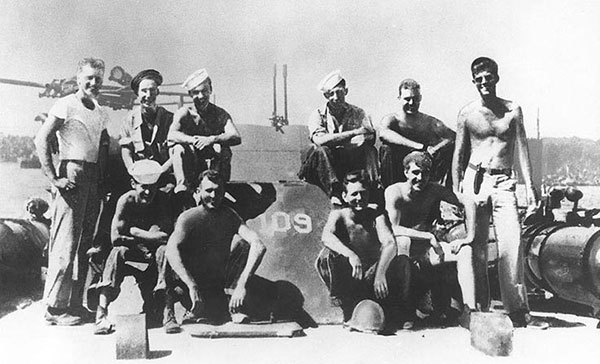
Collections of the U.S. National Archives and the Naval Historical Center
With dawn’s early light Kennedy was able to finally survey the extent of the chaos from the night before. Surrounded by Japanese ships in the area and facing the uncertainties of the sea Kennedy pondered "fight or surrender". He would later go on to state, "There's nothing in the book about a situation like this. A lot of you men have families and some of you have children. What do you want to do? I have nothing to lose." Towards the end of the following day he made the command decision to abandon the sinking wreckage of what once was the PT-109 and lead his men by swimming three miles towards the faint outline of a tiny island on the horizon. An officer who leads from the front and takes care of his men, Kennedy gave one of his wounded sailors a life jacket and then proceeded to tow the hapless sailor whereby Kennedy had to secure the tow rope in his teeth so he could have his arms free to swim.
After hours of swimming in the open Pacific Ocean, the crew of the 109 had finally made it to dry ground. Exhausted, they took their rest. Quickly Kennedy knew the island would not offer much due to a lack of food and water and with little respite from the blazing tropical sun. As his crew gathered their strength after a full day of surviving in the unpredictable ocean, Kennedy set out once again but this time alone to swim the arduous route he knew the PT Boats had taken through the islands hoping to find a friendly vessel or a better island to gather his crew. His search provided little and he returned to his crew. After spending several days on the barren little island, Kennedy surveyed his sailors' welfare and abilities and knew they had just enough strength to make yet another long swim to a larger island he spotted in the distance. The crew set out for a second arduous journey again with Kennedy tending to his wounded sailor. After 4 days with no food or water and exhausted, the crew of the 109 led by Kennedy crawled on to a beach of a second larger island where they found coconut palm trees. Finally they had found shade, food with the coconut meat and hydration with the coconut milk.
11 ALIVE…NEED SMALL BOAT…KENNEDY

John F. Kennedy Presidential Library and Museum
Confident that his crew was safe and secure, Lieutenant JG John Kennedy and his friend Ensign George Ross knew they had one more exhausting swim to make. They set out for yet a third trek this time to the tiny Island of Nauru several miles away faintly seen on the horizon where they were confident they would find local friendly natives. The locals of Naru must have been stunned when they witnessed the two American men wade ashore. The natives were trusting towards Americans after witnessing poor treatment at the hands of the Japanese. They were willing to help. Kennedy couldn’t risk attempting to canoe with the natives for fear of being seen by a Japanese patrol boat or plane. He instead cut a message on a coconut that read "NAURO ISL…COMMANDER…NATIVE KNOWS POS'IT…HE CAN PILOT…11 ALIVE…NEED SMALL BOAT…KENNEDY". He then handed the coconut to one of the natives and said, "Rendova, Rendova!,"
The next morning the natives returned with food and supplies. Kennedy discovered along with the provisions a letter from the coast watcher commander of the New Zealand camp. The letter directed for Kennedy to return with the natives whereby the New Zealand forces would unite him with U.S. forces. Not long after their rendezvous, Kennedy’s feeling of elation must have been immense as he watched the PT-157 rumble over to greet him. Shortly after picking up Kennedy, his crew of 10 sailors saw the 157 roaring towards their little island. After six long days, their skipper came through and they were going home.
A New Command: The PT-59 and Choiseul Island
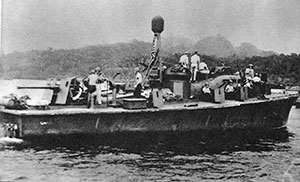
United States Navy Archives
After a few months of healing up in the rear but still wanting to stay in the fight, Lieutenant JG Kennedy requested another PT boat. In October 1943 he took command of PT-59. Kennedy, possibly doubtful of the Mark 8 and Mark 14 torpedoes’ abysmal performance decided to discard her torpedo tubes and convert her into purely a gunboat. He had two 40-millimeter anti-aircraft guns installed along with an additional array heavy machine guns. Reflecting on his battle experiences Kennedy did ballistics tests on heavy armor plating he had mounted along with his gun positions to ensure his crew’s survivability.
Kennedy’s venerable PT boat proved its valor when the 59’s crew sprinted towards Choiseul Island. Fifty US Marine of the 1st Marine Parachute Regiment were clinging to a beach head with an overwhelming Japanese force on the verge of over running them and pushing them into the sea. Kennedy and his crew roared in with guns blazing long enough to provide suppressing fire as the Marines made their way to the 59. The Navy crew loaded all Marines aboard, including several wounded. Kennedy had a severely wounded Marine taken to his bunk. Small arms rounds were hitting the wooden boat and bouncing off the armor plates Kennedy had installed. Kennedy gunned her engines and roared away from Choiseul. To his dismay the wounded man taken to his bunk had expired due to his wounds. He carried the rest of the grateful Marines to safety.
A Hero's Welcome Home
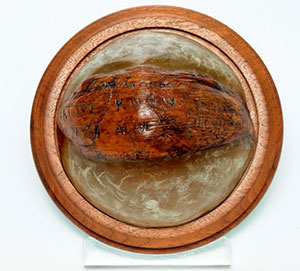
John F. Kennedy Library and Museum
John F. Kennedy was promoted to Lieutenant and continued as the skipper of the PT-59 but by 1944 the injuries sustained with the collision with the Japanese destroyer sent him stateside to receive treatment and physical therapy at Castle Hot Springs, a military hospital in Arizona. Sadly older brother Joe was killed in action piloting a British Mosquito night fighter in a top secret operation. John was honorably discharged in 1945. He would later undergo back surgery as a young U.S. Senator 8 years later.
For his service in World War II, John F. Kennedy received the Navy and Marine Corps Medal (the highest non-combat decoration awarded for heroism) and the Purple Heart. He also kept and had preserved the coconut shell with his inscrption "NAURO ISL…COMMANDER…NATIVE KNOWS POS'IT…HE CAN PILOT…11 ALIVE…NEED SMALL BOAT…KENNEDY" Years later when he was asked how he had become a hero, John F. Kennedy replied casually by saying “it was involuntary, they sank my boat”. Perhaps he was thinking these thoughts as he was contemplating his heroic stance in 1962. He had no choice but to order a naval blockade and stand firm, America’s cold war enemy was placing missiles in America’s backyard.
Tags
- john fitzgerald kennedy national historic site
- world war ii
- world war ii pacific
- jfk
- leaders
- president
- military experience
- military history
- kennedy
- kennedy family
- world war ii in the pacific
- world war ii valor in the pacific
- world war two
- irish
- irish-american
- irish-american heritage
- irish-american heritage month
Last updated: February 11, 2021
